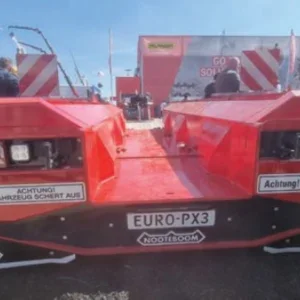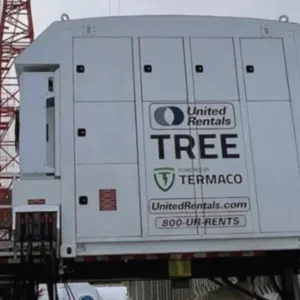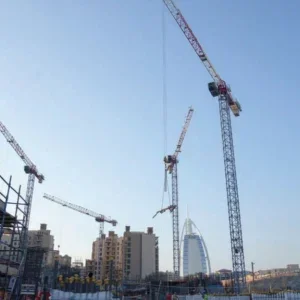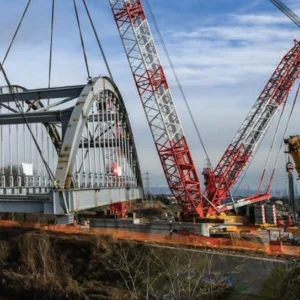Hydraulic loader cranes for timber handling are very different from the usual truck mounted hydraulic knuckle boom loader crane. European Standard EN12999 Cranes-Safety-Loader Cranes contains requirements that specifically apply to timber handling cranes. Like production loaders, these cranes are subjected to heavier use in that they operate at higher speed (with higher oil flow) and at a higher duty cycle than hydraulic cranes that are used mainly for what is described as hook duty or handling part loads, for example, delivering building materials.
Boom geometry is another difference. Many vehicle mounted timber loading cranes are non-folding because the main inner boom is too long. The combination of long inner boom with a shorter, but telescoping, outer boom is to give optimum performance. Folding types for timber handling, which take up less space, are known as Z cranes. These two types, usually referred to as L and Z, are the larger models, rated above 6tm, whereas forwarder cranes tend to be at the smaller end, below 6tm, and do not have outriggers. Harvester cranes are different again, vehicle mounted but fitted with a combined felling and de-limbing processor head. Timber loaders have an hydraulic log grapple with rotator mounted on the end of the boom, and a high seat is the usual operating position, sometimes with an enclosed cabin.
Cranes for loading timber operate in isolated areas without people in the working area so they do not require load indicators or limiters that prevent so-called dangerous load movements but they do need to prevent structural overload and risks to stability. A rated capacity limiter (RCI), which prevents dangerous movements, can cause a sudden stop which, due to the high operating speed of a timber loading crane, can introduce greater risks than a dangerous movement. A similar issue concerns hose failure where suddenly stopping a boom movement by means of load holding valves which lock the crane can be more risky than a controlled lowering of the load.
Most European manufacturers design their vehicle mounted hydraulic cranes to the German Norm DIN 15018, and the associated duty class. This standard for strength calculations is to be replaced, in Europe, with EN13001 which contains details of many different crane classes.
A design duty classification system from B1 to B6 is used to rate the service life of bearing components on vehicle mounted hydraulic loader cranes. Examples are B2 for hook duty, B3 for muckaway with a clamshell bucket, and B4 for timber loading and scrap handling. Cranes are usually built to one of the above categories rather than B1 (lightest duty) or B5 and B6 (heaviest duty). The classification relates to the most heavily loaded part of the crane, usually the column.
The B rating indicates the number of work cycles and therefore the service life of the crane. B2 is 60,000 work cycles, B3 is 200,000, B4 600,000 and B5 is 1,000,000 cycles. For a B4 class crane this can be calculated as 300 maximum capacity lifts per eight hour shift over 10 years. Hook duty loaders might, on average, do five loads a day during their life. A timber loader will typically make 120 to 150 load cycles in a single shift day.
Also used is an ‘H’ classification that considers additional dynamic forces, when the crane is operating, for example, forces imposed if the crane comes to a sudden stop against an immovable object when lowering. H1 indicates 30% additional forces and H2 60%. Modern hydraulics allow additional dynamic forces to be limited to 30%, according to manufacturer Jonsered. Jonsered builds timber loading cranes according to strength calculations for Swedish standard IKH 4:30.1, which corresponds to DIN 15018, class H1/B4.
In addition to Jonsered, other main players in the timber handling crane market include Epsilon, owned by Palfinger, and Loglift which, like Jonsered and also Hiab, is part of the Partek group. Foresteri timber loaders and Patu forwarder cranes are both built in Finland by Kesla, another major manufacturer. The family owned Austrian manufacturer Penz also produces about 250 timber handling cranes a year, compared with a combined Partek Forest annual production of around 2,000 units. Epsilon produces around 600 a year. Other manufacturers include a couple in Eastern Europe and one in France.
Market situation
Demand for timber loading cranes is closely linked to the price of wood pulp which increased in the first half of 2002 and then steadied. Overall, current demand could be described as moderate, though there are exceptions. Ingemar Klack at Jonsered says that Scandinavian countries are at the moment quite busy in the sector. Mick Wright of UK Epsilon dealer TH White describes the UK market as quite buoyant.
Klack also says that Brazil is busy and doing well due to a favourable dollar rate, Germany is slow but moving upwards, and France is quiet as timber stocks are still high since the storms of late 1999 that felled trees corresponding to three years’ forestry. North America, he says, has been down for a couple of years due to a new import duty that is to be imposed by the USA on Canadian forestry products.
Kesla (Foresteri and Patu) reports a seasonal fluctuation as being responsible for low demand for forest machines in the first six months of this year. Deliveries in Europe and North-America were boosted by sales of new products, but these were mainly harvester heads and wood chippers.
The forestry industry, especially in Europe and North America, has long been a mature market but compensating for this is the fresher market for scrap handling, recycling and clamshell duty cranes. Sales are rising for Epsilon and Jonsered in these applications which have similarly high dynamic loadings and duty cycle requirement.
In the range
Epsilon has been developing its modular H1/B4 Evolution series for the last three years and the earliest examples have now been in service for more than two years. Newest in the range are the E250Z and E250L, both introduced at July’s Interforst forestry exhibition in Munich.
A range of models and different arm systems are combined to suit installation and customer requirements. There are foldable (Z) and non-foldable (L) versions from 9tm to 24tm and development of the long-timber series is now complete.
Development work has focused on improving ergonomics and safety while detail changes have further improved functionality, mobility, ease of maintenance and working speed. All Epsilon cranes now have drop down levers for protection to prevent damage caused by snagging on branches when travelling through wooded areas.
Epsilon fits double telescopic extensions as standard. According to Mick Wright all other manufacturers offer this as an extra option. A double rack slewing mechanism running in an oil bath is used for speed and durability, and a chain synchro-control system is designed to guarantee rapid double extension. Epsilon claims to be the first manufacturer offering internally routed and, therefore protected, hydraulic hoses and telescopic cylinders to prevent the common problem of torn hoses and bent or scored cylinder rods. All Evolution cranes have the cataphoretic paint finish (News April02, p9) for better service life.
Foresteri and Patu ranges are timber truck loaders from 6tm to 13tm with single or double extension, forwarder cranes from 4tm to 9tm and harvester cranes up to 12tm. They are produced at three factories in Joensuu, Kesälahti and Ilomantsi, Finland by a workforce of about 165 people.






